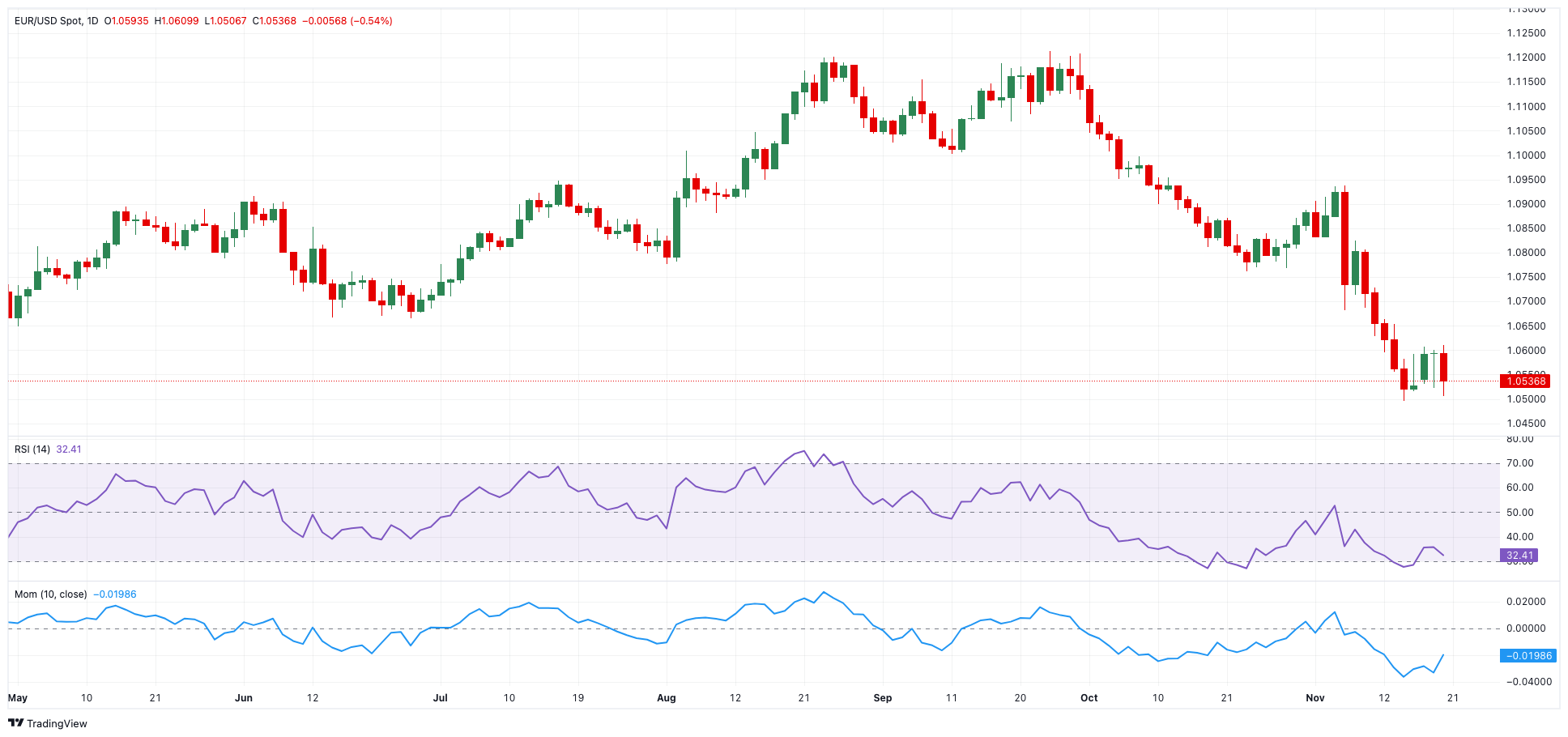EUR/USD Price Forecast: Further losses remain well in the pipeline
Premium|
You have reached your limit of 5 free articles for this month.
Get all exclusive analysis, access our analysis and get Gold and signals alerts
Elevate your trading Journey.
UPGRADE- EUR/USD added to the recent drop and tumbled to around 1.0500.
- The US Dollar picked up extra pace on the back of the “Trump trade”.
- EMU’s Negotiated Wage Growth surprised to the upside in Q3.
EUR/USD struggled to maintain its recent momentum on Wednesday, encountering increased selling pressure after yet another failed attempt to break above the 1.0600 level. This retreat, following Tuesday’s modest pullback, brought the pair closer to the 1.0500 zone.
The Euro's decline came amid renewed buying interest in the US Dollar (USD), fuelled by easing geopolitical concerns and the resurgence of the so-called "Trump trade." The US Dollar Index (DXY) gained significant traction, nearing the critical 107.00 threshold.
Additionally, a global rise in bond yields accompanied the pair’s steep decline, reflecting improved sentiment in the geopolitical landscape.
On the monetary policy front, the Federal Reserve (Fed) recently cut its benchmark interest rate by 25 basis points, bringing the target range to 4.75%-5.00%. This widely anticipated move aligns with the Fed’s efforts to steer inflation toward its 2% target. However, early signs of strain in the labour market are beginning to emerge, even as unemployment remains near historic lows.
In his recent comments, Fed Chair Jerome Powell emphasised that the central bank is not in a rush to implement further rate cuts, dampening hopes for a December reduction and adding late-session strength to the Dollar.
Supporting Powell's cautious stance, FOMC Governor Michelle Bowman stressed the importance of prioritising prudence in reducing rates. On the other hand, Governor Lisa Cook advocated for additional easing as long as inflation continues to move toward the Fed’s target.
Across the Atlantic, the European Central Bank (ECB) has also adopted a cautious approach. Following a reduction in its deposit rate to 3.25% in October, the ECB has chosen to pause further rate adjustments until new data offers more clarity on economic conditions.
Reinforcing the ECB's cautious stance, negotiated wage growth in the euro area rose to 5.42% during the third quarter, suggesting underlying inflationary pressures persist.
Looking ahead, potential policy changes—such as tariffs on European or Chinese goods under a possible Trump administration—could reignite inflationary pressures in the US. If the Fed remains cautious or adopts a hawkish tone in response, the Dollar could see additional support, keeping EUR/USD under pressure.
EUR/USD daily chart
Technical Outlook for EUR/USD
Further losses may push the EUR/USD down to its 2024 bottom of 1.0495 (November 14), seconded by the 2023 low of 1.0448 (October 3).
On the upside, the 200-day SMA at 1.0861 offers immediate resistance, ahead of the provisional 55-day SMA at 1.0911 and the November peak at 1.0936 (November 6).
Furthermore, the short-term technical picture is bearish as long as EUR/USD continues below the 200-day SMA.
The four-hour chart suggests that a consolidative range might be in the offing. However, initial resistance is at 1.0653, followed by 1.0726. The next negative objective is 1.0495, then 1.0448. The Relative Strength Index (RSI) treated water below 40.
- EUR/USD added to the recent drop and tumbled to around 1.0500.
- The US Dollar picked up extra pace on the back of the “Trump trade”.
- EMU’s Negotiated Wage Growth surprised to the upside in Q3.
EUR/USD struggled to maintain its recent momentum on Wednesday, encountering increased selling pressure after yet another failed attempt to break above the 1.0600 level. This retreat, following Tuesday’s modest pullback, brought the pair closer to the 1.0500 zone.
The Euro's decline came amid renewed buying interest in the US Dollar (USD), fuelled by easing geopolitical concerns and the resurgence of the so-called "Trump trade." The US Dollar Index (DXY) gained significant traction, nearing the critical 107.00 threshold.
Additionally, a global rise in bond yields accompanied the pair’s steep decline, reflecting improved sentiment in the geopolitical landscape.
On the monetary policy front, the Federal Reserve (Fed) recently cut its benchmark interest rate by 25 basis points, bringing the target range to 4.75%-5.00%. This widely anticipated move aligns with the Fed’s efforts to steer inflation toward its 2% target. However, early signs of strain in the labour market are beginning to emerge, even as unemployment remains near historic lows.
In his recent comments, Fed Chair Jerome Powell emphasised that the central bank is not in a rush to implement further rate cuts, dampening hopes for a December reduction and adding late-session strength to the Dollar.
Supporting Powell's cautious stance, FOMC Governor Michelle Bowman stressed the importance of prioritising prudence in reducing rates. On the other hand, Governor Lisa Cook advocated for additional easing as long as inflation continues to move toward the Fed’s target.
Across the Atlantic, the European Central Bank (ECB) has also adopted a cautious approach. Following a reduction in its deposit rate to 3.25% in October, the ECB has chosen to pause further rate adjustments until new data offers more clarity on economic conditions.
Reinforcing the ECB's cautious stance, negotiated wage growth in the euro area rose to 5.42% during the third quarter, suggesting underlying inflationary pressures persist.
Looking ahead, potential policy changes—such as tariffs on European or Chinese goods under a possible Trump administration—could reignite inflationary pressures in the US. If the Fed remains cautious or adopts a hawkish tone in response, the Dollar could see additional support, keeping EUR/USD under pressure.
EUR/USD daily chart
Technical Outlook for EUR/USD
Further losses may push the EUR/USD down to its 2024 bottom of 1.0495 (November 14), seconded by the 2023 low of 1.0448 (October 3).
On the upside, the 200-day SMA at 1.0861 offers immediate resistance, ahead of the provisional 55-day SMA at 1.0911 and the November peak at 1.0936 (November 6).
Furthermore, the short-term technical picture is bearish as long as EUR/USD continues below the 200-day SMA.
The four-hour chart suggests that a consolidative range might be in the offing. However, initial resistance is at 1.0653, followed by 1.0726. The next negative objective is 1.0495, then 1.0448. The Relative Strength Index (RSI) treated water below 40.
Information on these pages contains forward-looking statements that involve risks and uncertainties. Markets and instruments profiled on this page are for informational purposes only and should not in any way come across as a recommendation to buy or sell in these assets. You should do your own thorough research before making any investment decisions. FXStreet does not in any way guarantee that this information is free from mistakes, errors, or material misstatements. It also does not guarantee that this information is of a timely nature. Investing in Open Markets involves a great deal of risk, including the loss of all or a portion of your investment, as well as emotional distress. All risks, losses and costs associated with investing, including total loss of principal, are your responsibility. The views and opinions expressed in this article are those of the authors and do not necessarily reflect the official policy or position of FXStreet nor its advertisers.
